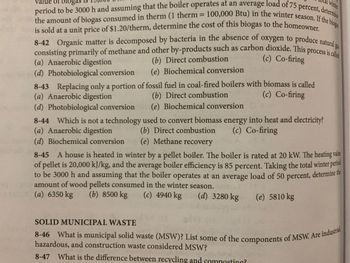
Concept explainers
Which is not a technology used to convert biomass energy into heat and electricity?

(a) Anaerobic digestion is a process that uses microorganisms to break down organic material in the absence of oxygen, producing biogas which can be used to generate heat and electricity.
(b) Direct combustion involves burning biomass in a boiler to produce steam, which is then used to generate electricity.
(c) Co-firing is the process of using biomass in combination with fossil fuels in power plants, in order to reduce greenhouse gas emissions and increase the proportion of renewable energy in the electricity mix.
(d) Biochemical conversion involves using enzymes or microorganisms to break down biomass into sugars, which can be converted into fuels or chemicals.
(e) Methane recovery is the process of capturing and using methane that is produced during the decomposition of organic matter in landfills, wastewater treatment plants, and other sources. The captured methane can be used to generate electricity or heat.
Trending nowThis is a popular solution!
Step by stepSolved in 2 steps

- Ocean thermal energy conversion (OTEC) plants use the temperature difference in the ocean (80°F at the surface and 40°F at 2000 ft. depth) in a Rankine cycle to generate electricity. Ammonia is the working fluid. Ammonia is boiled using the 80°F surface water, and condensed against the 40°F deep water, which is pumped to the surface. Very large heat exchangers are required, due to the small LMTDs and the low plant thermal efficiency (2.5%). The heat exchangers will comprise 40 % of the plant cost. In order to reduce the condenser cost, we will evaluate the condenser tube material savings provided by the use of a vertical fluted "Gregorig" condensing surface. The reference smooth tube condenser design uses 1.0 in. I.D. aluminum tubes, 0.062 in. wall x 30 ft. long. Sea water flows on the tube-side at 8 ft/sec. Ammonia condenses at 50°F on the outer surface of the vertical tubes with 4Tvs = 4°F. The ammonia properties at 48°F are: p= 39.1 lbm/ft³, k₁= 0.307 Btu/hr-ft- °F, и 1.426 × 10-2…arrow_forwardWhich statement/s are true? Heat is transferred to a system by either an air-sourced Carnot heat pump, an electrical resistance heater or a heat source at temperature marginally higher than the system temperature. The loss of Carnot Work Potential (Exergy destruction, or T0Sloss term) is minimum when heat is added by the air-sourced Carnot heat pump. Heat is transferred to a system either by an 100% efficient electrical resistance heater, or an 100% efficient isothermal heat source. The loss of Carnot Work Potential (Exergy destruction, or T0Sloss term) is zero when heat is added by the isothermal heat source. Heat is transferred to a system by either an air-sourced Carnot heat pump, an electrical resistance heater, or a heat source at temperature marginally higher than the system temperature. The loss of Carnot Work Potential (Exergy destruction, or T0Sloss term) is maximum when heat is added by the electric resistance heater. Heat is transferred to a system by either a…arrow_forwardIs creating energy and electricity through nuclear power plants, a sustainable energy source, in order to augment reliance on fossil fuels an ethical idea when compared to other technologies, such as solar, wind, and natural gas? If so, on what basis? If not, why, and is there anything that could bolster its ethical production?arrow_forward
 Elements Of ElectromagneticsMechanical EngineeringISBN:9780190698614Author:Sadiku, Matthew N. O.Publisher:Oxford University Press
Elements Of ElectromagneticsMechanical EngineeringISBN:9780190698614Author:Sadiku, Matthew N. O.Publisher:Oxford University Press Mechanics of Materials (10th Edition)Mechanical EngineeringISBN:9780134319650Author:Russell C. HibbelerPublisher:PEARSON
Mechanics of Materials (10th Edition)Mechanical EngineeringISBN:9780134319650Author:Russell C. HibbelerPublisher:PEARSON Thermodynamics: An Engineering ApproachMechanical EngineeringISBN:9781259822674Author:Yunus A. Cengel Dr., Michael A. BolesPublisher:McGraw-Hill Education
Thermodynamics: An Engineering ApproachMechanical EngineeringISBN:9781259822674Author:Yunus A. Cengel Dr., Michael A. BolesPublisher:McGraw-Hill Education Control Systems EngineeringMechanical EngineeringISBN:9781118170519Author:Norman S. NisePublisher:WILEY
Control Systems EngineeringMechanical EngineeringISBN:9781118170519Author:Norman S. NisePublisher:WILEY Mechanics of Materials (MindTap Course List)Mechanical EngineeringISBN:9781337093347Author:Barry J. Goodno, James M. GerePublisher:Cengage Learning
Mechanics of Materials (MindTap Course List)Mechanical EngineeringISBN:9781337093347Author:Barry J. Goodno, James M. GerePublisher:Cengage Learning Engineering Mechanics: StaticsMechanical EngineeringISBN:9781118807330Author:James L. Meriam, L. G. Kraige, J. N. BoltonPublisher:WILEY
Engineering Mechanics: StaticsMechanical EngineeringISBN:9781118807330Author:James L. Meriam, L. G. Kraige, J. N. BoltonPublisher:WILEY





